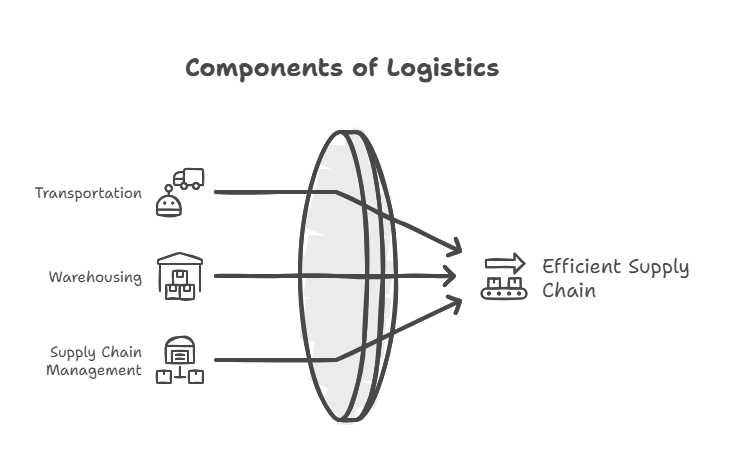-
Q. "Logistics is the backbone of a nation’s economic efficiency, and its transformation is essential for India’s journey from a developing economy to a developed one." Discuss. (250 words)
09 Jul, 2025 GS Paper 3 EconomyApproach:
- Introduce the answer by briefing about Logistics sector in India
- Give arguments to Logistics as the Backbone of Economic Efficiency
- Highlight Transformational Growth Trends in India’s Logistics Sector
- Delve into Persisting Challenges in India’s Logistics Sector and Suggest Transformational Reforms
- Conclude suitably.
Introduction
Logistics, encompassing transportation, warehousing, and supply chain management, plays a pivotal role in enabling economic growth by ensuring the smooth movement of goods and services.
- In India, the logistics sector contributes around 13-14% of the GDP, a figure higher than global benchmarks (~8%), indicating both its importance and inefficiencies.
Body:
Logistics as the Backbone of Economic Efficiency:
- Enabling Supply Chain Resilience: Logistics ensures time-sensitive delivery of goods, critical for sectors like pharmaceuticals, agriculture, and e-commerce.
- Efficient cold chains reduce post-harvest losses (~₹92,000 crore annually), enhancing food security.
- Supporting Manufacturing and Exports: With the PLI schemes and ‘Make in India’, manufacturing-led growth requires robust end-to-end logistics.
- For instance, India's merchandise exports reached $447.46 billion in 2022–23, heavily reliant on efficient port and multimodal connectivity.
- Driving Employment and Formalisation: The sector employs 22 million people, expected to add 10 million more jobs by 2027.
- Formalisation through policies like GST and National Logistics Policy enhances productivity and workforce skills.
- Enabling Regional and Global Connectivity: Initiatives like India-Middle East-Europe Corridor (IMEC) and Sagarmala improve trade linkages and maritime efficiency.
Transformational Growth Trends in India’s Logistics Sector:
- Robust Market Expansion: The sector grew at 11% CAGR (2019–24) and is projected to reach ₹35.3 trillion by 2029.
- Policy Support and Government Interventions: National Logistics Policy (NLP) aims to reduce logistics cost to 8% of GDP by 2030.
- PM Gati Shakti Master Plan integrates 1400+ data layers to improve multimodal infrastructure planning.
- Infrastructure and Modal Shift: Dedicated Freight Corridors (DFCs), 35 multimodal parks under Bharatmala, and improved port connectivity are reshaping the modal mix.
- Modal shift from roads to rail, coastal, and inland waterways is critical for cost efficiency.
- Digital Transformation: Platforms like ULIP, e-Sanchit, and tools like FASTag, IoT, and AI-based route optimization are streamlining logistics.
- India improved 6 places to 38th in the World Bank’s Logistics Performance Index (2023).
- Rise of E-commerce and Last-Mile Logistics: E-commerce projected to reach $200 billion by 2026, with logistics companies like Delhivery driving last-mile efficiency.
- Tech-enabled micro-warehousing and reverse logistics are expanding in Tier-II/III cities.
Persisting Challenges in India’s Logistics Sector:
Challenge Implications High Logistics Cost Reduces competitiveness of Indian exports and MSMEs Modal Imbalance Over-reliance on road (66%) inflates cost and emissions Fragmented and Unorganised Market Over 90% remains informal, limiting tech adoption Sustainability Issues Diesel-dependency and only 6,000 EV charging stations for commercial logistics Cybersecurity Risks Increasing digitisation exposes SMEs to data breaches and cyberattacks Transformational Reforms to Enhance Efficiency:
- Integrated Infrastructure Development: Fast-track DFCs, multimodal logistics parks, and last-mile rural connectivity.
- Emulate models like Mumbai Trans Harbour Link, improving access to Jawaharlal Nehru Port.
- Regulatory Simplification and Single-Window Clearance: Expand e-Sanchit to all logistics-related processes.
- Harmonise state regulations and enable faceless customs clearance.
- Digitisation and Technology Incentives: Promote tech adoption in MSMEs through subsidies and access to ULIP APIs.
- Develop India-specific logistics innovations in partnership with startups.
- Skill Development and Certification: Partner with e-commerce giants for last-mile skilling programs.
- Establish logistics-specific ITIs and certification standards.
- Green Logistics Push: Launch Green Logistics Certification Program. Promote EV adoption, coastal shipping, and low-carbon corridors (e.g., Sagar Sethu).
- Multimodal Integration and Freight Rationalisation: Implement multimodal hubs at economic clusters.
- Offer incentives to shift cargo from roads to railways and inland waterways.
Conclusion:
The National Logistics Policy (NLP) marks a transformative shift in India's approach to logistics by aiming to reduce logistics costs to 8% of GDP, enhance multimodal integration, and improve global competitiveness. With effective implementation, it can become a key enabler of India's transition from a developing to a developed economy, driving economic efficiency, export growth, and inclusive development.
To get PDF version, Please click on "Print PDF" button.
Print PDF





